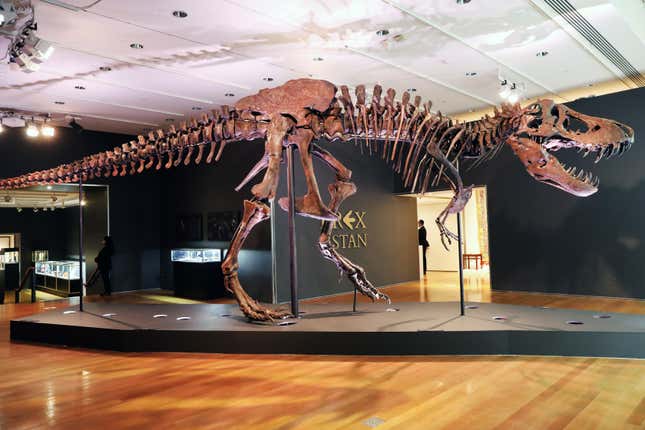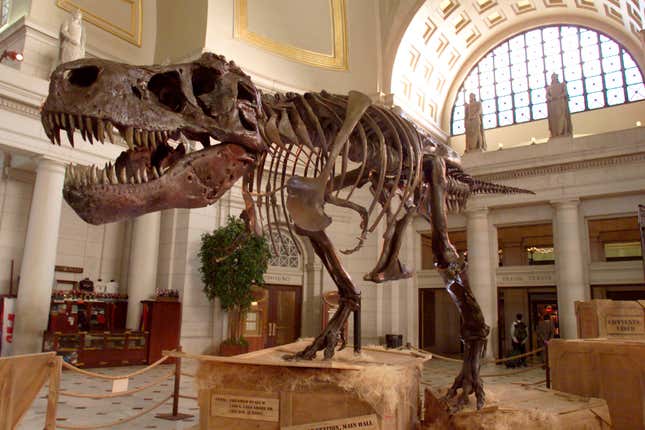
A roaring trade
Dinosaurs went extinct about 60 million years ago, but they’ve never been more profitable. This June, Universal will release yet another Jurassic World movie, marking over three decades of dino-domination. The franchise, which has grossed $6 billion, has reshaped how we think about dinosaurs. It’s also become a self-fulfilling prophecy.
It all began with Michael Crichton’s 1990 novel Jurassic Park, which imagined a world where dinosaurs walked the Earth again — for a price. When Steven Spielberg turned it into a 1993 blockbuster, it became a cautionary tale about the privatization of prehistoric life.
Thirty years later, that warning has come true: Dinosaurs, both fossilized and fictional, are firmly in the hands of the highest bidder. When the T. rex skeleton “Stan” sold for $32 million in 2020, it wasn’t to a paleontologist — it was to a museum-backed UAE investment firm. Scientists and researchers struggle to compete in such markets, relying on donations and loans to keep prehistoric giants accessible to the public.
However you cut it, dinosaurs are big business now, whether as $10 plastic T. rex toys or $45 million “alternative assets” a la Monets and first editions. The question is: Who owns the past? For more on that, stomp on down below.
By the digits
3.9 million: Visitors to the Smithsonian National Museum of Natural History in Washington in 2024, making it the most visited Smithsonian museum last year.
$44.6 million: Amount paid by hedge fund manager Ken Griffin in 2024 for “Apex,” a remarkably complete Stegosaurus fossil, marking the highest price ever recorded for a dinosaur specimen. (He’s loaning it to a museum.)
$845 million: Combined production costs of the two most recent Jurassic World movies, reflecting the franchise’s massive investment in bringing dinosaurs back to life on the big screen.
$1.114 billion: Total global box office revenue of the original Jurassic Park (1993), solidifying its blockbuster status.
$1.672 billion: Worldwide gross of Jurassic World (2015), making it the highest-earning film in the franchise thus far.
$5.4 billion: Mattel’s sales in 2024, with its product portfolio including Jurassic World toys as well as perennial favoritesBarbie and Hot Wheels.
One economy that’s NOT going extinct
If you’ve ever been dragged through the Target toy aisle by a dinosaur-obsessed toddler or scrambled to track down a plastic Indoraptor for your niece’s birthday, you’ve seen one side of the dinosaur economy: consumer demand that never goes extinct.
Parents spend millions each year on dino-themed toys, books, museum memberships, park visits, and birthday parties. Mattel’s Jurassic World toy line is a reliable money maker, with its dino sales sometimes outpacing its Star Wars toys. Netflix has also cashed in, launching Jurassic World: Camp Cretaceous and Jurassic World: Chaos Theory, animated series for young fans. There’s even a (frankly brilliant) LEGO crossover.
Even without Hollywood’s influence, kids naturally fixate on dinosaurs. Psychologists call it a “conceptual domain” obsession — a phase when children develop intense interest in a single topic, often tied to classification and discovery. But while middle-class parents empty their wallets on tchotchkes, billionaires hoard the real thing, with hedge fund managers, tech CEOs, and art collectors driving fossil prices ever higher.
Private ownership of fossils isn’t new: Famous specimen Sue the T. rex was the subject of a high-stakes legal battle and became one of the first dinos sold at auction. But with prices skyrocketing, some paleontologists worry that significant scientific discoveries are being locked away in private collections instead of advancing research. The result is one more widening gap: While kids fill their rooms with plastic dinosaurs, the actual bones are disappearing into the hands of rich collectors.
Quotable
“Stan was 25,000 person-hours. That’s a lot of work. And, you know, somebody has to pay for that.” —Peter Larson, president of Black Hills Institute of Geological Research, speaking to Freakanomics’ Zachary Crockett about the auction of “Stan” the T. rex.

Pop quiz
Which of the following dinosaur-related items has actually been sold for tons of money?
A. A McDonald’s Jurassic Park Happy Meal toy that was recalled in 1993.
B. A T. rex skull sold to Nicolas Cage — who later had to return it to Mongolia.
C. A fossilized dinosaur egg that hatched after being warmed in a laboratory.
D: A complete Brontosaurus skeleton auctioned to a Vegas casino.
Check out the answer at the bottom of this email.
Brief history
1677: The first dinosaur bone ever discovered (a Megalosaurus femur) is mistaken for a giant human’s thigh bone or possibly his scrotum. Science has come a long way.
1915: The first mounted T. rex skeleton goes on display at the American Museum of Natural History, sparking dino fever and cementing gift shop sales forever.
1990: Michael Crichton’s Jurassic Park is published, imagining a world where dinosaurs are cloned for profit. It sells nine million copies before the movie even premieres.
1993: Steven Spielberg’s Jurassic Park hits theaters, changing dinosaur pop culture forever and grossing over $1 billion.
2025: Universal prepares to release yet another Jurassic World movie. Somewhere, a velociraptor negotiates a backend deal and final script approval.
Fun fact!
In 2022, during an ESPN interview with Eli Manning, Dwayne “The Rock” Johnson showcased a life-sized replica of a Tyrannosaurus rex skull that he referred to as “Stan” in his home office. This sparked widespread speculation that he was the anonymous buyer who had purchased the actual Stan fossil for $32 million in 2020. However, Johnson clarified that his “Stan” is a replica cast made by the Black Hills Institute of Geological Research, not the original fossil.
Watch this
Freakonomics dives into the bizarre world of dinosaur auctions in this episode unpacking how T. rex skeletons became multimillion-dollar commodities.
Poll
What’s the best way to invest in dinosaurs?
- A: Buy a $30 million T. rex skeleton and put it in my living room like a normal person.
- B: Corner the market on plastic dino toys and wait for Mattel to call.
- C: Launch a luxury Jurassic NFT collection — because this time, crypto will definitely work.
- D: Use CRISPR to bring dinosaurs back and start a boutique petting zoo. What could go wrong?
💬 Let’s talk
🐤 X this!
🤔 What did you think of today’s email?
💡 What should we obsess over next?
Today’s email was written by Catherine Baab-Muguira, whose four-year-old is obsessed with dinosaurs and inspired her to write this piece.
The correct answer to the pop quiz is B. In 2007, Nicolas Cage won a bidding war against Leonardo DiCaprio for a $276,000 T. rex skull. Turns out, it was looted from Mongolia, and Cage later had to return it.